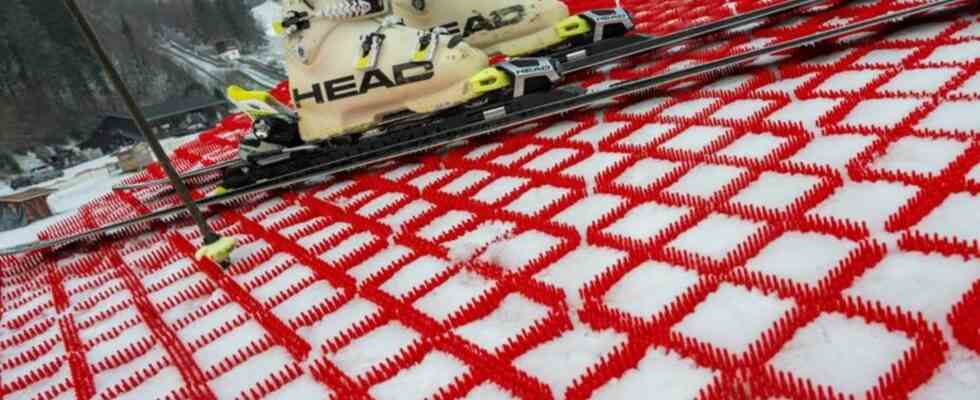climate crisis
new trend? Snow-free turns on a synthetic slope
A man is standing with his skis on a ski slope that has been prepared with special plastic mats. The mats can be used for skiing all year round. photo
© Peter Kneffel/dpa
In many ski areas, nothing has been possible without artificial snow for a long time. This season, however, even snow cannons were no longer working. Now some are trying snow that won’t melt away.
The kids think it’s “cool”. For the first time, they slide downhill on plastic mats instead of on snow. Snow is scarce this season. Green meadows and idle lifts – that was the picture in many areas for weeks. It was often too warm even for flakes from snow cannons, with around 20 degrees at the end of the year. The Bergbahnen Hocheck in Oberaudorf are taking a new approach: operations on a matted slope started on Friday.
Just as the first guests, including children from the Top on Snow ski school, try their bows, it begins to snow. The real slope should finally open on Saturday. However, the mats are not intended as a full replacement. “It rounds things off, complements it,” says Hannes Rechenauer, Managing Director of Bergbahnen. Several media had reported on the Hocheck slope.
At first glance, it is a cross between artificial grass and doormats, on which children and a few adult ski fans slide downhill. The approximately 800 square meter slope cost around 80,000 euros – measured against the endless slopes of Switzerland, Austria or France, a small speck in the landscape.
“I came here skeptically,” says the head of the ski school, Rupert Nagl. But after the test: “The ski feeling is very similar to snow”. For beginners, this is a very good opportunity to practice. “Skiing experience, of course it’s not winter sports.” Little Veronika has fun with her friends, but: “I like normal snow better.”
A short journey protects the climate
The hope of Bergbahn boss Rechenauer: that ski courses with the mats will start as early as October and “beginners and returnees can try their first turns. You don’t have to switch to glaciers”. Shorter journey – good for the climate.
However, environmentalists are not enthusiastic. They refer to energy-intensive production, microplastic abrasion and damage to meadows that are worthy of protection. “Mats also bring ecological problems,” says Martin Geilhufe from the Bund Naturschutz in Bayern. A farmer who manages a nearby pasture thinks: It’s an event, good for the region. But with a view to microplastics: “I can’t even get a plastic straw for the children anymore.” The manufacturers refer to documents that are intended to absorb the abrasion.
Mats have been used in ski jumping for decades, in 2022 for the first time in the World Cup. The people of Copenhagen take turns on a waste incineration plant. There are also a few mostly small textile slopes in other countries and in Germany. British racer Dave Ryding only raced on mats as a child before competing on snow for the first time at the age of twelve. A year ago, in Kitzbühel, he celebrated the first ever World Cup success by a Briton in Alpine skiing.
Not an issue in Bavaria yet
People tend to be more reserved in the ski region of Bavaria. At the Bayerische Zugspitzbahn it is said that “up to now they have never thought about mats. We don’t see it as an alternative to snow.” The Association of German Cable Cars also sees no trend. “The real winter business is skiing on snow, outside in of nature, in the fresh air and in front of a mountain panorama.” Now there is fresh snow, one looks confidently to the rest of the season.
However, manufacturers are reporting increasing demand for the heat-resistant snow substitute, especially this season. “Our warehouse is empty. Goods are still going out every day,” says Jens Reindl, managing director of the Chemnitz company Mr. Snow, which calls their product, which is partly made of cotton, “textile snow”. Reindl’s customers include ski schools and clubs in Saxony, Sauerland, Kleinwalsertal and the Bavarian Forest. The carpets are white and green – depending on whether they should be left in the summer.
The Oberaudorf company Skitrax World sees an international future market. “We have projects in the realization for new mat ski slopes ranging in size from 1,000 to 8,000 square meters and more,” says Managing Director Wolfgang Schmidt.
Talking to Saudi Arabia
One is in contact with an Arab investment company for mat slopes in Saudi Arabia in the Trojena ski area, which can then be used all year round, says Schmidt. Above all, Arab states and many Asian countries are interested. In view of the bad winter in the Alps, he also expects further orders from European ski areas. There is a professional alternative for the snowless time – “but it is not yet socially acceptable”.
In Willingen in Sauerland, children at the Upland ski school have been sliding downhill on textile snow for eight years when there is a lack of snow. “There’s less and less snow and it’s often not cold enough – but I’ve always been able to open my ski school all the time,” says the owner. “I think the mats are very good.”
Most agree: the winter experience in a snow-covered landscape cannot be replaced by the mats. So winter sports enthusiasts and lift operators hope for the snow, which should finally come.

